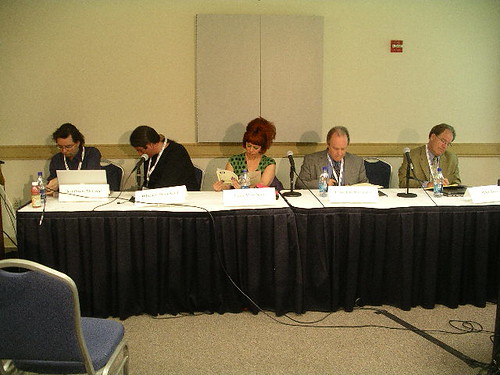Whitney Broussard Owner, Whitney Broussard Consulting
E. Michael Harrington Professor Of Entertainment & Music Business, Belmont University
Peter Jaszi Professor of Law , Washington College of Law
Lady Miss Kier singer/songwriter/producer, Dee-lish Publishing/Deee-lite
Kembrew McLeod Assistant Professor, University of Iowa

11:22AM EST - KM: Public Enemy's older work is mixed up with literal hundreds of samples, similar to a more current artist Girl Talk, who released an album last year with over 150 samples. We're here to talk about artists like this and the bigger questions surrounding sample licensing.
LMK: I got really popular because of Herbie Hancock sample on "Groove is in the Heart." We didn't know anything about the business, we looked at sampling as a new instrument.
PJ: To me, fair use seems to say that certain uses of copyrighted work are defensible, because they add to the greater culture they draw from. Why aren't these defenses always being made? Because of the difficulty that artists have in figuring out the doctrine out. The solution to that is collective self help. I've worked with different groups to help them define collectively their own relevant fair use doctrine.
11:36AM EST - KM: How could the industry legitimize an album like Girl Talk's Night Ripper?
WB: Most major record companies would just throw up their hands and say "we're not going to do it, it's just too much work." Each license can be a few thousand dollars just in transaction costs. Added up, most companies probably wouldn't do it. Majors aren't in it for the art. On an underground level, Dangermouse's Grey Album for example, is successful.
LMK: Look at the break from "funky drummer." That guy never got paid. It's bad creative karma to not clear your sample.
MH: I had this crazy idea in 2001 about a compulsory license to sample sound recordings. I thought that with a recording from the last 10 years, you could take 10 seconds or 10%, whichever is less, and pay 25% to the sampled artist.
11:44AM EST - KM: We often think of Fair Use as applying in an educational or journalistic context. How can we think of it in terms of sampling?
PJ: A somewhat unified theory of Fair Use has emerged. What courts are asking is: was the original material transformed, or significantly re-contextualized? This applies to the full-range of cultural practices, including music-making, for commercial and non-commercial uses.
WB: A forgotten aspect of Fair Use, is that its not the only way you can use copyrighted works, for example using such a small sample of the piece that it doesn't rise to the level of infringement, period.
11:52AM EST - WB: It's important to not that there are different standards for advertising than art, even if the art is being sold. We don't want to see people conflating the problems of advertising and music copyright.
11:58AM EST - KM: There are all these licensing land-mines out there to be aware of. There was a while, on Rhapsody and Napster, where you would only see partial albums, because they couldn't secure full rights.
11:58AM EST - Questions from the audience
Q: At iTunes, we generally don't distribute a record unless we have blanket clearance from the label. Once it has been cleared for commercial distribution, why must it be re-cleared for digital distribution?
WB: It's a contract issue, not a legal issue.
PJ: It's risk-assessment. The copyright owner wants to make sure he is not giving too much away.
Q: Without insurance and indemnities, almost nothing will work. if you are the owner of a right, its incumbent on you to get the splits cleared. The song "Grillz" has 29 different publishing clearances, but congrats to them for doing it.
KM: But can independent artists afford the lawyers to clear these things, or are we excluding the middle and lower tiers of recording artists?
Q: Can someone define de minimis use?
WB: Unfortunately there isn't a clear definition, much as there isn't for Fair Use. A major label isn't going to want to rely on either of these; they will take the position that if you can recognize it, you have to clear it.
Another point is that the tools of production are so accessible. It's one thing to talk about industry practices, but its another thing to tell kids what to do. Part of me thinks we should have less stringent licensing requirements for sampling, but another part of me thinks that there is nothing cooler than listening to a record that shouldn't legally exist.
Q: Does the music from sample clearances ever make it back to the artist?
WB: The sad reality is that it almost never does. At best they will see 50%, but generally they don't see any of it.
Q: Peter, am I inferring correctly from your previous comments that if, say, a local hip-hop coalition were to state its intentions for Fair Use sampling, this might indemnify them against infringement suits?
PJ: Essentially, yes. The larger the community backing such a document, the more credence the courts will lend it if an infringement suit comes along.

No comments:
Post a Comment